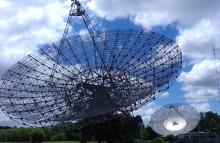
Abstract
The Argentine Institute of Radio astronomy (IAR) is equipped with two single-dish 30mts radio antennas capable of performing daily observations of pulsars and radio transients in the southern hemisphere at 1.4 GHz. We aim to introduce to the international community the upgrades performed and to show that IAR observatory has become suitable for investigations in numerous areas of pulsar radio astronomy, such as pulsar timing arrays, targeted searches of continuous gravitational waves sources, monitoring of magnetars and glitching pulsars, and studies of short time scale interstellar scintillation. We refurbished the two antennas at IAR to achieve high-quality timing observations. We gathered more than 1000 hours of observations with both antennas to study the timing precision and sensitivity they can achieve. We introduce the new developments for both radio telescopes at IAR. We present observations of the millisecond pulsar J0437−4715 with timing precision better than 1~μs. We also present a follow-up of the reactivation of the magnetar XTE J1810--197 and the measurement and monitoring of the latest (Feb. 1st. 2019) glitch of the Vela pulsar (J0835--4510). We show that IAR is capable of performing pulsar monitoring in the 1.4 GHz radio band for long periods of time with a daily cadence. This opens the possibility of pursuing several goals in pulsar science, including coordinated multi-wavelength observations with other observatories. In particular, observations of the millisecond pulsar J0437−4715 will increase the gravitational wave sensitivity of the NANOGrav array in their current blind spot. We also show IAR's great potential for studying targets of opportunity and transient phenomena such as magnetars, glitches, and fast-radio-burst sources.